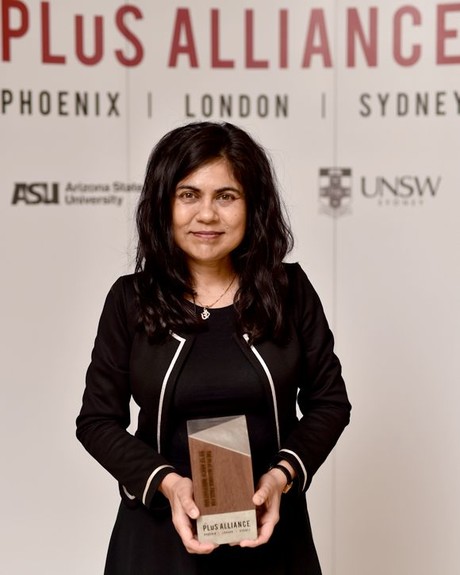Looking beyond the three Rs

Traditionally, the recycling industry has always looked at the three Rs — reduce, re-use, recycle. But Professor Veena Sahajwalla from the Centre for Sustainable Materials Research and Technology (SMaRT) is challenging this thinking with her ‘new science of green manufacturing’ that looks at the fourth R — reform.
Many may remember the UNSW Professor’s ‘green steel’ making process, which was commercialised by OneSteel. Professor Sahajwalla won many awards for this process in which old rubber tyres are used as a partial replacement for coke in electric arc furnace steelmaking.
Now she has been awarded the PLuS Alliance Prize for Research Innovation for her latest research project ‘The new science of green manufacturing’, which is developing technologies to convert complex waste materials into ‘green’ materials for use in industry. She says she’s humbled to win this award as she believes her ‘new science’ reform will not only provide potential economic benefits for industry but it also incorporates social justice, as so much of our waste currently ends up in developing countries.
A recent report on ABC’s Four Corners program made revelations that it’s currently cheaper to stockpile and landfill glass waste than to recycle it. Greens Senator Peter Whish-Wilson responded to the report, saying that the crisis in Australia’s recycling industry has been “a long time coming”.
“The fall in commodity prices has demolished the previously successful business model based around co-mingled kerbside recycling,” he explained.
Professor Sahajwalla agrees that we can’t keep depending on the same old ways of recycling. She said traditional recycling business models have always looked at recycling glass back to glass, plastic back to plastic, etc, but there are limitations with recycling this way as everything has to be so clean and cross-contamination can make the process highly resource intensive.
The new science of green manufacturing moves beyond this traditional way of thinking about recycling, explains Professor Sahajwalla. “We don’t just focus on one solution but rather the full spectrum of possible solutions in order to transform products into different higher value products.
“Once we have a range of solutions, it’s then important to consider each solution in the context of what society needs and what makes good economic sense.”
So in the context of the glass recycling example: “Basically, glass is around 70% silica (SiO2),” she said. “We look at how we can tap into the input resource and make the highest value output product possible. In this case, the glass could be reformed into a ferro-silicon alloy, a metallic alloy that is highly value added.”
Then, instead of transporting waste to one big centralised location with rigid conditions that may only enable one output, Professor Sahajwalla explains that smaller, decentralised microfactories could be co-located where the waste might be stockpiling.
The professor’s concept revolves around the establishment of micro factories which are flexible enough to produce high-value products that are economically viable. These smaller microfactories will use a selective thermal transformation technology that may be able to produce a range of different types of alloys from the one input waste resource, in a more energy-efficient manner.
“Our science looks at a whole range of inputs. We look at how they might react when processed and determine the most efficient way to produce high-value outputs.”
The team at UNSW is working with industries to research into the high temperature transformation of waste that is rich in metal and plastic, and one such example is e-waste. The team doesn’t just look at extracting the high-value copper from the boards. It also looks at how the plastic waste can be monetised from other e-waste resources that are rich in plastics. Professor Sahajwalla explains in this example how firstly the team identified that the 3D printing market is currently an evolving market. They then determined that the plastic from e-waste could be converted into one-dimensional filaments using their microfactory technology and these filaments can then be used as feedstock for 3D printing. “So we are creating something of a higher value for a growing market and this enables the technology to flourish on a localised level,” she said.
Another example being researched is automotive waste recycling. “Obviously, steel is recycled from automotive waste, but a large amount of waste plastics from cars still ends up in landfill,” said Professor Sahajwalla. “Microfactories could recycle these plastics into high-value ceramics, for example, which can then be utilised in meaningful ways.”
Professor Sahajwalla and her team have looked after new science and technology of green manufacturing, microfactories. Now, according to the professor, many industry partners both here and abroad are interested in possibly further commercialising this technology. At this stage, she is reluctant to predict any winners.
“The work we’ve been doing to help global industries use green materials over virgin raw materials is vital to sustainability,” Professor Sahajwalla said. “This recognition from the PLuS Alliance for the work we’ve been doing to drive change and impact communities across the world is a real honour.”
How Sydney's OS Passenger Terminal slashed its waste costs
Veolia has delivered a custom-designed solution that cut the Overseas Passenger Terminal's...
Sludge treatment: a weighty issue
Sludge dewatering might not be the most glamorous process, but it is a vital part of ensuring...
Getting closer to a circular economy for plastics
A new process that vaporises hard-to-recycle plastics in order to make recycled plastics has been...









